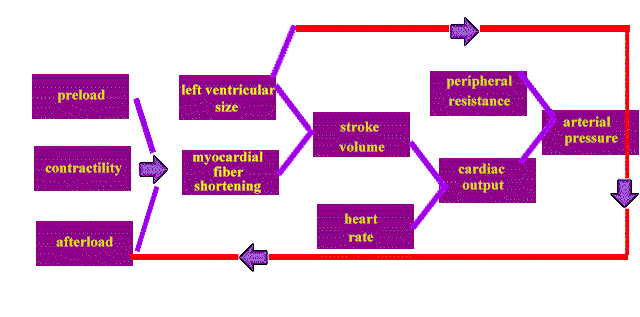|
press  above to
begin the lecture above to
begin the lecture
and
install current free versions of Quicktime,
if needed, to support lecture series audio!
Table
of Contents
-
Essential
Hypertension
-
Classification
of Arterial Hypertension
-
Control of
Blood Pressure
-
Antihypertensive
Drug Mechanisms
-
Baroreceptor
Reflexes
-
Antihypertensive
Drugs and Anesthesia
-
Hypertension:
Organ Systems Effects:
|
|
Essential
Hypertension (greater than 90% of cases)
-
Occurs in patients who
have arterial hypertension without a clear,
definable cause.
-
Essential hypertension is
also referred to as primary or idiopathic
hypertension.
Classification of Arterial
Hypertension
I. Systolic
hypertension
II.
Systolic and Diastolic
hypertension
|
Renal
-
Renovascular stenosis or
renal infarction
-
Polycystic kidney disease
-
Acute and chronic
glomerulonephritis
-
Chronic pyelonephritis
-
Renin-producing tumors
-
Other severe renal
diseases)
|
Endocrine
|
|
Neurogenic
|
Miscellaneous
|

Control of Blood
Pressure
Arterial pressure is determined by a
number of interacting factors
Physiological Factors
Influencing Arterial Pressure
-
Preload & Contractility:
-
As blood volume returning to the
heart increases, preload increases and
there is enhanced filling with
ventricular dilation.
-
According to Starling's Law,
increased ventricular stretch usually
leads to increased contractility.
-
Increased preload and
increased contractility lead to increased
stroke volume and ultimately an increase
in arterial pressure, all other factors
remaining equal.
-
Some antihypertensive drugs
decrease preload.

Antihypertensive
Drugs and Anesthesia
-
There is probably excessive concern
about interaction potential between anesthetics
and antihypertensive drugs.
-
Areas of concern for administration
of anesthetic to patients treated with
antihypertensive medications:
-
Maintenance of antihypertensive drug
treatment during perioperative time frame:
Stoelting, R.K., "Antihypertensive Drugs",
in Pharmacology and Physiology in Anesthetic Practice, Lippincott-Raven
Publishers, 1999, 302-312.
|